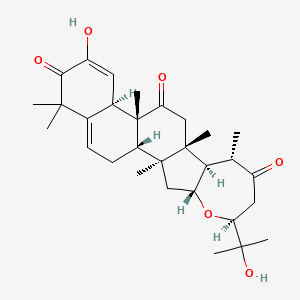| Authors | Title | Published | Journal | PubMed Link |
|---|---|---|---|---|
| Dinan L et al. | Assessment of natural products in the Drosophila melanogaster B(II) cell bioassay for ecdysteroid agonist and antagonist activities. | 2001 | Cell. Mol. Life Sci. | pmid:11289314 |
| Himeno E et al. | Structures of cayaponosides A, B, C and D, glucosides of new nor-cucurbitacins in the roots of Cayaponia tayuya. | 1992 | Chem. Pharm. Bull. | pmid:1464123 |
| Kawahara N et al. | Two new cucurbitacin glucosides, opercurins A and B, from the Brazilian folk medicine "Buchinha" (Luffa operculata). | 2004 | Chem. Pharm. Bull. | pmid:15305007 |
| Shaw JT and Hummel HE | A monitoring trap for Diabrotica virgifera virgifera and D. barberi adults lured with a poisoned cucurbitacin bait. | 2003 | Commun. Agric. Appl. Biol. Sci. | pmid:15149093 |
| RÃos JL et al. | Cucurbitacins as inducers of cell death and a rich source of potential anticancer compounds. | 2012 | Curr. Pharm. Des. | pmid:22443631 |
| Ayyad SE et al. | In vitro and in vivo study of cucurbitacins-type triterpene glucoside from Citrullus colocynthis growing in Saudi Arabia against hepatocellular carcinoma. | 2012 | Environ. Toxicol. Pharmacol. | pmid:22245841 |
| Hira SK et al. | Downregulation of endogenous STAT3 augments tumoricidal activity of interleukin 15 activated dendritic cell against lymphoma and leukemia via TRAIL. | 2014 | Exp. Cell Res. | pmid:25139620 |
| Attard EG and Scicluna-Spiteri A | Ecballium elaterium: an in vitro source of cucurbitacins. | 2001 | Fitoterapia | pmid:11163940 |
| Kirschman JC and Suber RL | Recent food poisonings from cucurbitacin in traditionally bred squash. | 1989 | Food Chem. Toxicol. | pmid:2792979 |
| Yang K et al. | [Clinical application of anticancer nanoparticles targeting metastasis foci of cervical lymph nodes in patients with oral carcinoma]. | 2003 | Hua Xi Kou Qiang Yi Xue Za Zhi | pmid:14732978 |
Cucurbitacin S
Cucurbitacin s is a lipid of Sterol Lipids (ST) class. The involved functions are known as establishment and maintenance of localization and nitric oxide biosynthetic process.
Cross Reference
Introduction
To understand associated biological information of Cucurbitacin S, we collected biological information of abnormalities, associated pathways, cellular/molecular locations, biological functions, related genes/proteins, lipids and common seen animal/experimental models with organized paragraphs from literatures.
What diseases are associated with Cucurbitacin S?
There are no associated biomedical information in the current reference collection.
No disease MeSH terms mapped to the current reference collection.
PubChem Associated disorders and diseases
What pathways are associated with Cucurbitacin S
There are no associated biomedical information in the current reference collection.
PubChem Biomolecular Interactions and Pathways
Link to PubChem Biomolecular Interactions and PathwaysWhat cellular locations are associated with Cucurbitacin S?
There are no associated biomedical information in the current reference collection.
What functions are associated with Cucurbitacin S?
Related references are published most in these journals:
| Function | Cross reference | Weighted score | Related literatures |
|---|
What lipids are associated with Cucurbitacin S?
There are no associated biomedical information in the current reference collection.
What genes are associated with Cucurbitacin S?
There are no associated biomedical information in the current reference collection.
What common seen animal models are associated with Cucurbitacin S?
There are no associated biomedical information in the current reference collection.
